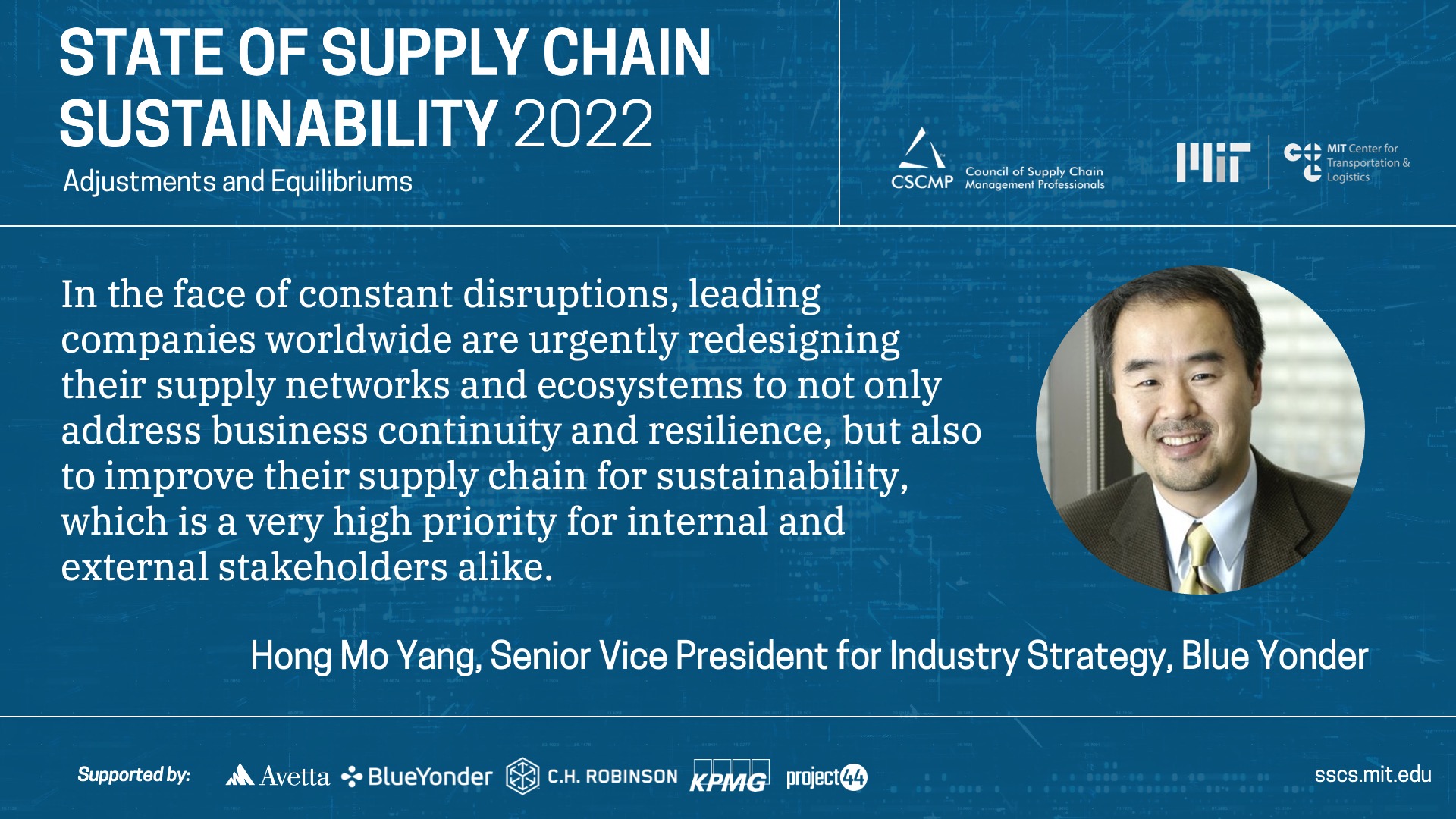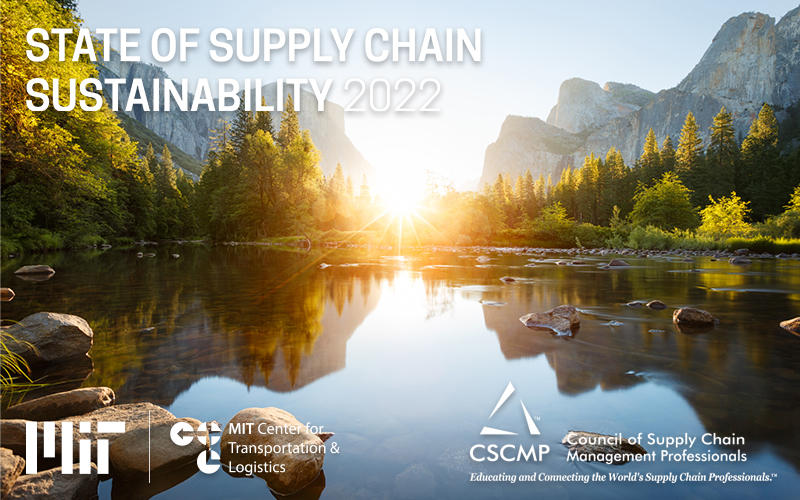Sustainability Efforts are Gaining Momentum Even Though Sustainability is a Moving Target
The importance of supply chain sustainability (SCS) is trending upward – and that’s a positive! This insight comes from the 2022 State of Supply Chain Sustainability Report, presented by the MIT Center for Transportation & Logistics (MIT CTL) and the Council of Supply Chain Management Professionals (CSCMP), sponsored by Avetta, Blue Yonder, C.H. Robinson, KPMG, and project 44. Let’s explore the key insights and implications for supply chain and logistics decision-makers and professionals from this report.
Key Themes
This is the third year of the annual report. For the second year in a row, over 80% of respondents reported that they are maintaining their SCS goals during the COVID-19 pandemic. Last year, the report observed that the initial acceleration of SCS efforts were for improving supply chain resilience and risk management. This year, it observed that these efforts are becoming more widespread with supply chain circularity and the adoption of technology also gaining steam.
Sustainability Engagement Up However Organizational Challenges Still Exist
The motivation to improve SCS is increasing. As executives who were interviewed for the report observed, companies are determined to do better after suffering from the effects of the pandemic. Improved visibility and awareness of the supply chain are helping, especially in the face of significant amount of supply chain disruptions. Similarly, Blue Yonder’s 2022 Supply Chain & Logistics Executive Survey, which looked into the latest sentiments of company executives across industries on supply chain disruptions, sustainability, and investments topics, found that 43% had invested in sustainability when asked what areas they have invested in over the last year.
The 2022 State of Supply Chain Sustainability Report found that SCS initiatives are being set up and actions are being taken. From what the report described as the “Staircase of SCS practices,” companies are starting at the bottom of the staircase with supplier audit, supply chain mapping, and code of conduct for suppliers and for the companies themselves.
When asked about their openness in disclosing SCS information, respondents expressed that their companies are actively collecting data and reporting outcomes on their website, in corporate reports, and in press release. However, barriers still exist in cross-organizational efforts and reporting – “the next frontier of SCS,” according to MIT CTL.
A key question, in my mind, is how deeply engaged are the stakeholders? From three years ago where many respondents mentioned that they belong to the “not at all engaged” category, MIT CTL observed an increase in respondents identifying themselves as decision-makers and those directly engaged with SCS initiatives this year!
In a Part 2 blog post, we will further explore the popular issues that companies are setting up corporate goals around to impact sustainability and highlight the investments that they are planning to make.
Aim to Save the World
Sustainability should be included as a key pillar of an enterprise’s digital journey today. Hong Mo Yang, Senior Vice President – Industry Strategy, Blue Yonder, observes that, “In the face of constant disruptions, leading companies worldwide are urgently redesigning their supply network and ecosystem to not only address business continuity and resilience, but also to improve their supply chain for sustainability, which is a very high priority topic for internal and external stakeholders alike.”

In my view, the key reasons for the urgencies are:
- Existential: Sustainable business practices are quickly becoming a top priority. Corporations are heading toward that direction because of customer preference (highlighted in my previous blog, “3 Ways to Drive Sustainability in Transportation”), legal risks (e.g., the recent Costco case), and government regulations (e.g., the European Green Deal seeks a 90% reduction in these emissions by 2050).
- Economic: Sustainability improves profitability (e.g., materials reuse, energy efficiency, transportation empty miles savings). New products and services can open up revenue streams.
- Environmental: Each step in the value chain has a potential impact on the planet. Businesses are realizing that they have a part in a better, sustainable tomorrow.
- Emotional: From a Deloitte study, “52% of consumers reported making a sustainability-based purchase within the previous four weeks.” And Blue Yonder’s 2022 Consumer Sustainability Survey found that nearly half (44%) of consumers said their interest in shopping sustainably increased since the start of the pandemic. There is more and more evidence to show that shoppers value sustainable products and brands.
The industry needs are growing. Across customer packaged goods (CPG), Industrial Manufacturing, Distribution and Third-Party Logistics, and Retail industries, companies are reimaging their operations for the circular economy. How can they embark on new products innovations to improve operations, source ethical ingredients and materials, and enhance demand planning and logistics execution?
Blue Yonder is committed to environmental responsibility by developing solutions that help our customers meet their sustainability goals. The following are some example imperatives for enterprises to build sustainable supply chains:
- Improve demand planning and forecast accuracy to avoid over-production, ordering or stocking.
- Source goods ethically and use efficient packaging while at the same time providing transparent standards for your company and your suppliers.
- Optimize logistics operations to maximize asset utilization, improve operational and labor efficiency, and reduce spoilage.
- Through optimization techniques and clean energy, decrease the negative environmental impact of transportation, distribution, and logistics operations.
- Increasing digitalization across your supply chain to enhance energy efficiency and reduce manual errors.
- Gain digital-like flexibility, control, and visibility through a control tower for your supply chain processes, assets and operations.
More Insights to Come
In a Part 2 blog post, in addition to exploring the popular issues and company investments as mentioned above, we will go into more detail about some of the innovations and solutions that will help organizations move along the supply chain sustainability journey.
- To read the full State of Supply Chain Sustainability Report, click here.
- To read the e-book “Building Sustainable Supply Chains: A Quick Start Guide,” click here.
- To learn more about how Supply Chain and Blue Yonder can save the world, click here.
- Join us for a Blue Yonder Live session on Aug. 16 at 4 p.m. ET to discuss «The Shifting Supply Chain Sustainability Focus.» We will be joined by representatives from MIT CTL, CSCMP, and project44 to discuss the key trends from the report and what’s driving sustainability for organizations.

